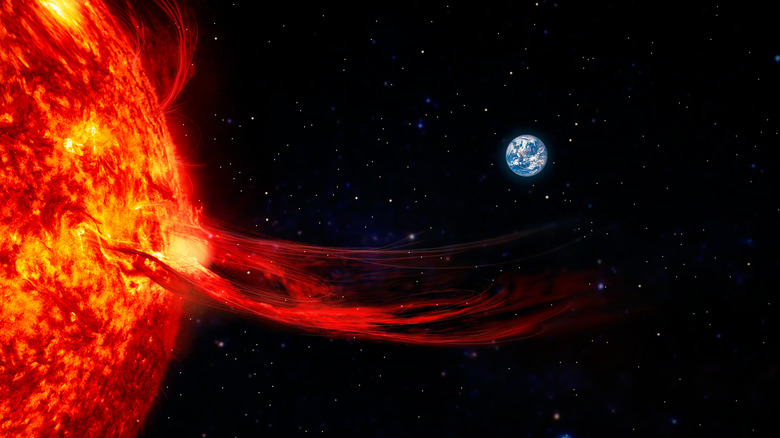How Are Astronauts Protected From Space Radiation?
One of the most deadly environmental dangers in outer space is something entirely invisible: radiation. Powerful outbursts from the surface of the sun send charged particles flying through space — these and other factors contribute to dangerous space radiation.
Here on the surface of our planet, we are protected from radiation by the Earth's magnetosphere and atmosphere. The magnetosphere is a field around the planet created by the movement of molten metals within the planet's core, and it both shields us from cosmic rays and helps prevent the atmosphere from being eroded (via NASA). The magnetosphere is also responsible for the famous Northern Lights, as well as other beautiful auroras seen in certain regions of our world.
However, the magnetosphere only extends so far. When astronauts travel away from the planet's surface and into space, they are no longer protected by it and so are exposed to radiation. That means solutions to the radiation problem have to be considered for space missions of all kinds. NASA has had to account for radiation in orbital missions aboard the International Space Station (ISS), space travel, and missions to our moon. NASA and other space agencies have been developing ways to protect astronauts for a long time.
"The danger of radiation is always present, whether you're in orbit, in transit, or on a planetary surface," said a NASA expert in human spaceflight, Ruthan Lewis, of the Goddard Space Flight Center (via NASA). Lewis suggests that NASA considers radiation in every environment astronauts will encounter in the future, concentrating on everything "from mitigation techniques to protection and enclosures,"
Protection from radiation
It's hard for radiation to pass through solid materials, so one of the best ways to protect astronauts is to build thick metal shielding into their spacecraft or future habitats. But such shielding is heavy, which makes it difficult to launch. One option for future missions to the moon or to Mars is to use materials that already exist in these places as protection against radiation. One example of this from NASA is the piling up of Moon regolith (soil) over shelters for radiation shielding.
On Mars, regolith alone probably won't be enough to keep astronauts safe from radiation, but it could be a useful addition to other shielding methods. Another option is to make use of natural features on the planet like lava tubes — caverns that run under the surface of the planet that could provide shelter to astronauts. Researchers have explored the possibility that Martian buttes could be massive enough to provide some measure of protection for future explorers as well.
These solutions are focused on creating shelters for astronauts, but as in any mission, they will likely need to move around unsheltered areas as well. For that purpose, astronauts on the International Space Station have been testing out a radiation shielding vest called the AstroRad vest. The vest doesn't cover the whole body, but it does cover the vital organs which are most vulnerable to radiation exposure.
A matter of lifetime exposure
Radiation isn't always an instant killer – for the kinds of space missions we're talking about, the level of radiation that astronauts will experience will not likely be a short-term health hazard. It's more likely that repeated exposure over time will be what leads to an increased risk of cancer.
"Our goal is to limit the risk of radiation exposure over an astronaut's lifetime," said Kerry Lee, a NASA radiation scientist who worked on radiation protection for the Orion spacecraft soon to be used in moon missions (via NASA). "It's not likely you'd see acute effects of radiation during a mission or immediately upon return, but we are concerned about long-term effects."
There's a lot we're still learning about how radiation affects the body, especially with the amount of exposure that would happen on a mission to Mars. But there is also research underway on whether there are drugs or certain antioxidant-rich diets which could help keep astronauts sufficiently protected from radiation's effects, both long-term and short-term.
Studies using data from sources like the Curiosity rover have found that missions to Mars should be safe for humans given current radiation protections — as long as the missions don't last more than four years. It's a good start, but before we're fully confident that we'll be able to safely send astronauts to Mars and beyond, there still remains a lot we need to learn about radiation and a lot of work that needs to be done in order to sufficiently protect our people for the long haul.
